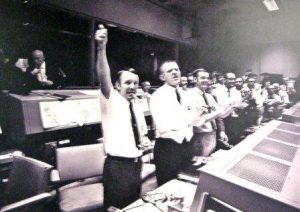Cassini–Huygens: A View OF Mission Control
Want to Improve Your Communication Skills? Look to NASA.
Apollo 13 is one of my favorite movies. Anyone who has ever worked with me knows how frequently I’ll reference this excellent film which reenacts one of the most stellar (pun intended) American achievements and moments in history. It is chock full of great examples of team work, leadership, personal accountability, problem solving and good ole ingenuity.
So, when I learned that I could watch an early morning, live stream of the Cassini–Huygens Mission Control as

Source NASA/JPL‐Caltech
they witnessed the triumphant end of their highly successful exploration of Saturn, I grabbed my coffee and bellied up to my monitor!
I was not disappointed. Just like in Apollo 13, everyone cheered, clapped, hugged, shook hands, and cried. No acting here—just pure emotion. Success! How did they pull it off?
How did professionals from 160 different countries manage to build, launch and command a 22×13 ft., 17,000+lbs. spacecraft for 20 years—as it whizzed through space at 76,000 miles per hour—from 900 million miles away? I’ll go out on a limb here and guess that, in addition to all that team work, leadership, personal accountability, problem solving and ingenuity, NASA demands excellence in communication. Ah yes—that wonderful glue that makes everything in life easier—good communication. And you thought it was wine!

Source NASA
I suspect that when human endeavors fail, it’s due to poor communication. Failure happens because somewhere along the line, someone didn’t listen or someone gave lousy instructions, or no instructions—and nobody confirmed that everyone was on the same page. NASA can’t risk poor communication, so using precise protocols for giving and receiving directions are part of their culture. Roger that, Houston.
Speaking clearly, succinctly, and deliberately helps, too. Did you ever work with someone who gives extraneous information when giving directions? I did. I learned to translate and separate the wheat from the chaff, but those less skilled at deciphering his manner of speaking were often scolded when they got things muddled. “I couldn’t have made myself any clearer!” he would complain. I wondered how he came to that conclusion when the outcome indicated otherwise!
If you want to be an effective communicator with those you manage, or those that manage you, start every conversation with a sharp awareness that every interaction requires productive direction giving, active listening and confirmation that it was all understood. Three parts—don’t waiver. Don’t assume. NASA doesn’t assume.
There are a few areas I think cause the most issues. Follow the tips below and you can reduce communication glitches.
- Teach and / or learn your common vernacular. When you communicate within a team, make sure everyone understands shared nomenclature, abbreviations and references. Conversely, if you are new and don’t understand something, ask what they mean. Don’t just hope you will eventually figure it out. At NASA, the commands “Start countdown sequence” and “Prepare for lift-off” signal a series of activities where everyone knows what to do and what will happen. I understand what these imply, but no one wants me in the control room!
- Use positive directions. Clearly say what has to be done instead of what shouldn’t be done. Again, “Prepare for lift-off” is not the same as “Stop doing what you are doing, the rocket has to launch soon.” Or, if you need to, give both a positive and a negative direction such as “Walk, don’t run!”
- Be aware of the skill level and experience of the people receiving your directions. Less experienced people may need piecemeal directions and more frequent check-ins to make sure they are on the right track. Cassini was a 20-year mission—job handoff was inevitable. Bringing the newbies up to speed required patience and exactness.
Poor communication is miscommunication. The results are never good and can be catastrophic. It may be impossible to achieve zero miscommunications, but the effort will be well-worth the attempt. Business leaders can simply think like NASA and create a company culture that appreciates how effective communication saves time, money, frustration, and helps avoid disasters. Start with communication protocols, employee training and accountability—and be a superstar example.
At JJ Miller we are passionate about small business!

Source Unsplash ‐ Juskteez Vu
Our services are designed with smaller operations in mind and our mission is to help small businesses have the same advantages as larger firms. What sets us apart is our approach. We use solutions form-fitted to each client’s needs to avoid the loss of agility, innovation and that entrepreneurial spirit that makes small business so vital. JJ Miller reviews, improves, and develops sustainable internal processes that make sense for our client’s industry, size and culture.
